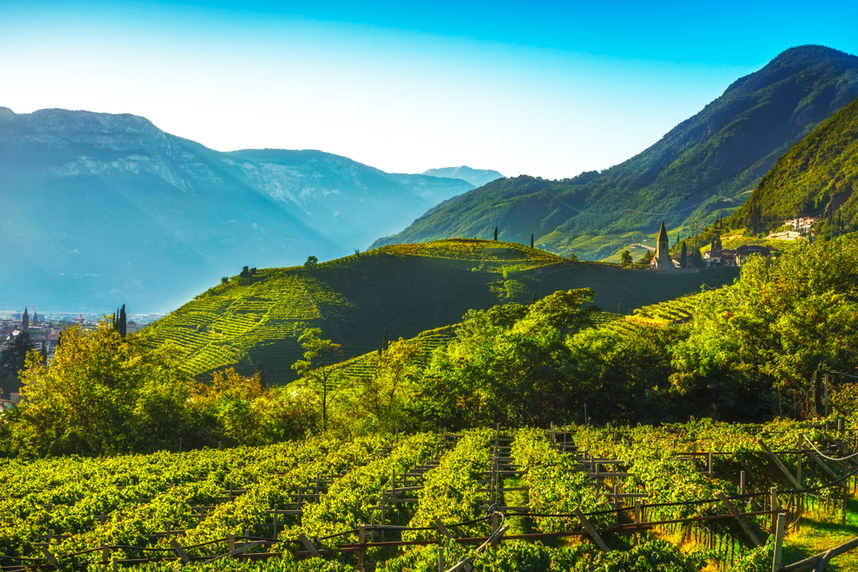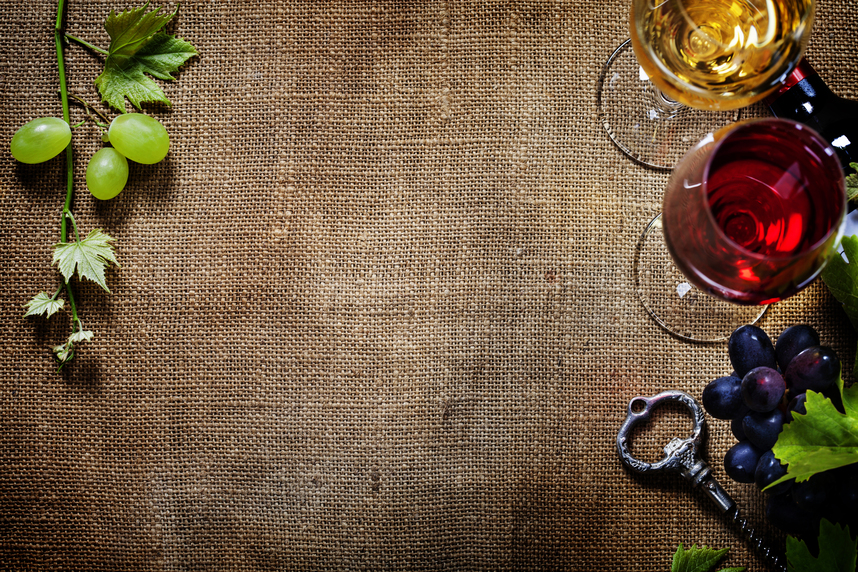Anyone wishing to describe in words the role that Trentino-Alto Adige plays within the oenological sector, would find themselves confronted with a multifaceted region that is difficult to enclose within a clear-cut classification. On the one hand high slopes, on the other valley floor terrain, on yet another the shores of Lake Garda, territories characterised by geological and climatic diversity, responsible for the production of fine bottles.
The journey to discover the wines of Trentino-Alto Adige starts right here: from the history and characteristics of a place that has given a lot (and continues to do so) to the world of wine!
Viticulture in Trentino-South Tyrol: origins and history
One of the most relevant testimonies to the history of vine-growing in Trentino-Adige is entrusted to a copper vase, probably used during wine-related rituals, found in Valle di Cembra in 1825 and renamed 'Situla Etrusca'. Dating back to around the 4th century B.C. and attributable to the Rhaetic peoples who occupied the region before the arrival of the Romans, this vase suggests that vine cultivation in the region was already consolidated, and later amplified during the Roman period.
With the spread of the monasteries and mercantile activity across the Brenner border, wine production in Trentino continued considerably throughout the Middle Ages, with constant refinement of cultivation and winemaking techniques and a maximum extension of the area under vine during the period of annexation to the Austro-Hungarian Empire.
With the foundation of the Provincial Agricultural Institute of San Michele all'Adige by Edmund Mach in 1874, scientific experimentation further elevated the typical wines of Trentino-Alto Adige. In order to continue to guarantee the quality of the product, the Comitato Vitivinicolo trentino and the Carta viticola del Trentino were created in 1948, the latter a careful and technical examination of local wine production.
Constant efforts by producers and scholars to foster, enhance and promote this activity led to the founding of the Trentino Wine Institute in 1994 and the Consorzio di tutela vini del Trentino in 2011.
Not only mountains: the main production areas of Trentino wines

The multifaceted nature of Trentino-Alto Adige is evident from the moment one has to talk about the terroir of its wines, which enjoy different conditions depending on the area. It is therefore impossible to speak of a wine landscape, while it is much wiser to speak of landscapes, characterised by different altitudes, climatic conditions, inclinations and morphological traits.
The composition of the soils ranges from the alluvial clay soils typical of the valley floor areas, to the good dryness of the hillside soils, to the higher altitude areas (between 500 and 900 m) characterised for the most part by porphyritic debris and sandy, calcareous and gravelly soils.
As far as climate is concerned, the Alpine areas provide Trentino-Alto Adige vines with cool temperatures and a good temperature range, while the Mediterranean climate near Lake Garda mitigates the colder temperatures of Trentino winters.
The excellence of the regional wines is attributable to the experience of the individual wineries, but the fertility of the main wine-growing areas in Trentino-Alto Adige should not be underestimated:
- Piana di Trento: where cultivation focuses mainly on white grape varieties, such as Chardonnay and Pinot Bianco, as well as excellent bubbles, among which the Trento DOC Metodo Classico stands out.
- Vallagarina: Marzemino and sweet Moscato production area.
- Valle dell'Adige: area dedicated to the cultivation of white and red grape varieties, such as Chardonnay, Merlot, Schiava and Pinot Bianco. An excellent area for Teroldego.
- Piana rotaliana: exceptional home of Teroldego Rotaliano.
- Val di Cembra: the soils characterised by steep slopes have been shaped by the work of man to create dry terraces for the production of Pinot Bianco, Chardonnay, Muller Thurgau and Nosiola.
- Valle del Sarca: the great protagonist of this area is the Nosiola vine and its sweet declination, the Vino Santo Trentino DOC.
- Bassa Atesina: gives the consumer wines with good structure and considerable aromatic charge, such as the much-loved Gewürztraminer.
- Bolzano and Merano: soils rich in porphyry and granite give rise to excellent varietals of Schiava and Lagrein.
- Oltradige: the mild climate and good sun exposure make this area an ideal terroir for many white grape varieties.
- Valle dell'Adige: sandstone-type soil that gives the whites a characteristic mineral note. Sauvignon, Pinot Bianco, Lagrein and Schiava grapes are most popular.
- Vinschgau: Pinot Noir and Riesling grow on sandy soils in a dry climate.
- Valle d'Isarco: characterised by limestone soils of dolomite origin, home of Lagrein, Schiava, Sylvaner, Kerner and many fine whites and reds.
The red wines of Trentino-Alto Adige
This region offers a wide range of red grape varieties, including Teroldego, Lagrein, Pinot Noir, Marzemino, Schiava, Merlot and others. This diversity of grapes, combined with the area's unique altitude and climate, contributes to the richness and complexity of Trentino red wines, which often have a remarkable balance of fruitiness, acidity and tannins.
Teroldego
Typical of the Piana Rotaliana, but not only, it is the Trentino red par excellence, nicknamed the 'gold of Tyrol' in past centuries and the bearer of the best characteristics of Trentino-Alto Adige red wines.
Rich in anthocyanins - which colour the grape skins and, as a result, give the wine a very intense ruby red hue - Teroldego comes from the indigenous grape variety of the same name and presents itself on the palate with a decisive and complex character. Its aromatic profile welcomes notes of berries, ripe cherries and spices, while on the palate it boasts an excellent balance between sugar component and bitter aftertaste, between softness and acidity.
The taste of a Teroldego Vigneti delle Dolomiti IGT, for example, is warm and vigorous, with evident but rather moderate tannins, perfect for gastronomic pairings of various kinds. A Teroldego Rotaliano DOC - which also lends itself to ageing - worthily accompanies traditional Italian first courses, such as lasagne and pasta served with meat sauces, as well as local dishes and main courses, such as polenta, mushrooms and sausage with sauce. Surprisingly, it does not disdain seafood and sushi dishes either, thus demonstrating excellent adaptability in the kitchen.
Lagrein
Often considered the cousin of Teroldego, it shares with it the primacy of being one of the most famous red wines of Trentino, although it was vinified in white until the 18th century. South Tyrolean by birth (but related to the French Pinot Noir), this wine is produced in the province of Bolzano from the vine of the same name, both in the more common red version (called Dunkel), and in rosé.
The liveliness of Lagrein Trentino DOC is to be found in its organoleptic profile, which displays intense aromas of berries and violets, as well as spicy hints that do not go unnoticed. Notes of chocolate and cloves stand out on the nose, with a light smoky background that reinforces the strong character of this wine. On the palate it is soft and caressing, moderate in alcohol content but not in elegance, perfect for grilled meats, stewed meat recipes and tasty game, but also full-bodied polenta dishes with mushrooms and traditional Italian first courses.
Trentino-Alto Adige: the region's most famous whites
The white wines of Trentino-Alto Adige are renowned for their freshness, elegance and aromatic complexity. This region produces a wide range of white wines, each with its own specific characteristics, all to be discovered.
Gewürztraminer
On the origin of one of Trentino-Alto Adige's best-loved aromatic whites, the debate is still open. Some place it in Alsace and others in Alto Adige. What is certain is that today it is considered the king of regional whites, vinified from a naturally sweet grape with spicy tones.
As rich in its aromas as it is in its flavour profile, the Gewürztraminer first of all conquers the eye thanks to its straw-yellow colour with elegant golden highlights. On the nose, it is suave and bewitching, with its aromas full of exotic fruits and flowers, and hints of citrus and spices, including cloves and gingerbread.
There are numerous dishes that can be paired with its strong, structured flavour, characterised by a gritty liquorice aftertaste that does not, however, compromise its freshness. It can be paired with sushi as well as with truffle recipes and mature cheeses, but - thanks to its subtle sweetness - it also makes a splendid impression alongside traditional desserts, such as a good slice of apple strudel, also characterised by spicy notes.
Kerner
Born in Germany in 1929 from a cross of Schiava and Rhine Riesling, the grape variety has found an excellent area in Trentino to thrive, even at altitudes of 800-900 metres above sea level, thanks to its great resistance to cold climates.
Fresh and mineral, Kerner Alto Adige DOC is a full-bodied, well-structured wine, whose aromas of flowers and white-fleshed fruit are enriched by distinctive hints of nutmeg and spices. Examination of the palate reveals a full flavour and moderate acidity, lower than the Riesling from which it is derived. These characteristics make it an excellent wine to accompany aperitifs and vegetable menus, but also grilled fish dishes and spicy recipes typical of ethnic cuisine.
Bubbles and sweet wines of Trentino
The bubbles and sweet wines of Trentino-Alto Adige are highly favoured by wine enthusiasts, thanks to their quality, elegance and freshness, as well as their versatility in food pairings.
Trento DOC
Thanks to the spread of the classic method in the area in 1850 and the perfectioning of sparkling wine techniques by Giulio Ferrari in the early 1900s, Trentino-Alto Adige bubbles are particularly noteworthy.
The most important Metodo Classico of the region is the Spumante Trento DOC, which encapsulates in its organoleptic characteristics all the best of the Trentino-Alto Adige terroir.
The illustrious child of second fermentation in the bottle, Trento DOC bears the traits of this prized sparkling method, including the unmistakable hints of yeast.
The Alpine nature of its terroir can also be perceived in its distinct minerality, softened by exotic fruit aromas. The persistent and fine perlage is perfect for refreshing aperitifs of various kinds, from rustic to fried, passing by a delicious platter of cold meats and local cheeses. Also excellent with risottos and pasta dishes, for main courses it prefers ingredients that are not too full-bodied, such as white meats and fish dishes.
Pink Muscat
Rosé with an intense aromatic soul, vinified from a part of the grapes dried after the harvest and a part left to ripen on the vine. Perfumed and with a good sugar concentration, Moscato Rosa has nuances ranging from light cherry to deep red, while the nose unleashes an incredible aromatic richness, composed of spicy hints of cinnamon and cloves, with suggestions of dog rose.
Sweet and full-bodied to the taste, with a bottle of Moscato Rosa Vigneti delle Dolomiti IGT the gastronomic pairings in Trentino-Alto Adige are quite simple: dry pastries and desserts that are not excessively sweet, such as a slice of apple strudel. However, it also adapts perfectly to pairings with blue cheeses.
Continue exploring the best wines of Trentino-Alto Adige by checking out Svinando's selection!

